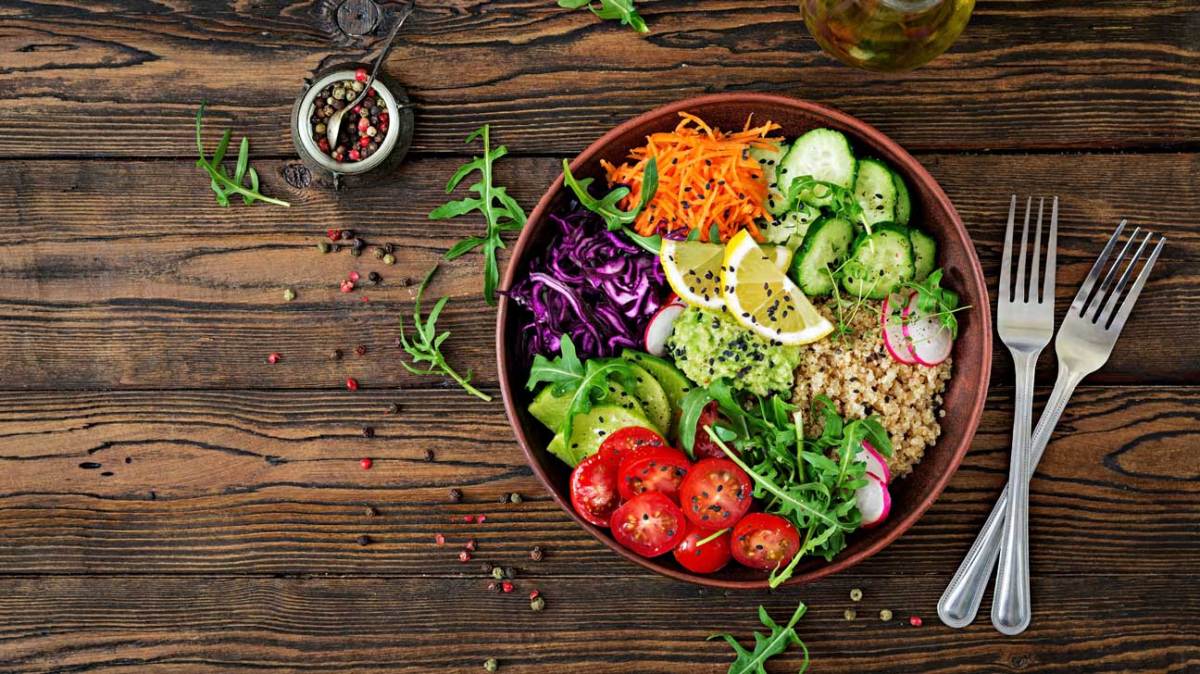Embark on a culinary journey into the vibrant world of vegetarian cuisine! This guide provides a delicious and accessible pathway to transitioning to a plant-based diet. We’ll equip you with practical planning tools, mouthwatering recipes, and essential cooking techniques, making the shift not only manageable but also incredibly enjoyable. Discover how to effortlessly incorporate nutritious and flavorful vegetarian meals into your daily life, addressing common concerns and celebrating the incredible diversity of plant-based ingredients.
From creating a personalized weekly meal plan to mastering essential cooking techniques like sautéing and roasting vegetables, we’ll cover every step of the process. We’ll explore the nutritional benefits of various vegetarian dishes, highlighting excellent sources of protein and fiber. We’ll also tackle common challenges, offering practical solutions for maintaining a balanced and satisfying vegetarian diet. Get ready to savor a world of exciting flavors and textures!
Planning Your Vegetarian Transition

Embarking on a vegetarian journey is a rewarding experience, filled with the discovery of vibrant flavors and the satisfaction of a healthier lifestyle. A well-planned transition ensures a smooth and enjoyable shift, avoiding feelings of deprivation and promoting long-term success. Careful consideration of meal planning, grocery shopping, and gradual integration are key components of a successful transition.
A structured approach to incorporating vegetarian meals into your diet minimizes the potential for setbacks and maximizes the likelihood of lasting change. This involves a gradual increase in vegetarian meals, mindful grocery shopping, and a flexible attitude towards experimentation with new recipes and ingredients.
Weekly Vegetarian Meal Plan
This sample meal plan provides a diverse range of vegetarian options, showcasing the versatility and deliciousness of plant-based cuisine. Remember to adjust portion sizes to meet your individual caloric needs.
| Day | Breakfast | Lunch | Dinner |
|---|---|---|---|
| Monday | Oatmeal with berries and nuts | Quinoa salad with roasted vegetables | Lentil soup with whole-wheat bread |
| Tuesday | Tofu scramble with spinach and mushrooms | Black bean burgers on whole-wheat buns | Vegetable stir-fry with brown rice |
| Wednesday | Smoothie with spinach, banana, and almond milk | Leftover vegetable stir-fry | Vegetarian chili with cornbread |
| Thursday | Yogurt with granola and fruit | Salad with chickpeas and avocado | Pasta primavera with seasonal vegetables |
| Friday | Breakfast burrito with black beans and sweet potatoes | Leftover vegetarian chili | Pizza with vegetables and vegan cheese |
| Saturday | Pancakes with fruit and maple syrup | Buddha bowl with roasted sweet potatoes, chickpeas, and kale | Mushroom risotto |
| Sunday | French toast with berries | Leftover mushroom risotto | Vegetarian lasagna |
Grocery List Based on Meal Plan
This list reflects the ingredients needed for the weekly meal plan, emphasizing seasonal produce for optimal flavor and cost-effectiveness. Adjust quantities based on your household size and preferences. Remember to check your pantry for existing staples.
- Produce (Seasonal Adjustments Recommended): Berries, spinach, mushrooms, onions, garlic, bell peppers, zucchini, squash, carrots, potatoes, sweet potatoes, kale, avocado, tomatoes, lemons, bananas
- Grains & Legumes: Oatmeal, quinoa, brown rice, whole-wheat bread, whole-wheat buns, cornbread, pasta, lentils, black beans, chickpeas
- Dairy Alternatives (Optional): Yogurt (dairy or non-dairy), almond milk
- Protein Sources: Tofu, nuts, seeds
- Other: Olive oil, spices, maple syrup, vegan cheese (optional)
Tips for Gradual Vegetarian Meal Integration
Successfully transitioning to a vegetarian diet often involves a gradual process, allowing your body and palate to adjust.
- Start with Meatless Mondays: Designate one day a week for vegetarian meals, gradually increasing the number of vegetarian days as you feel comfortable.
- Substitute, Don’t Eliminate: Instead of completely removing meat, start by substituting meat-heavy meals with vegetarian alternatives. For example, replace one meat-based dinner a week with a vegetarian one.
- Focus on Flavor: Experiment with diverse spices, herbs, and cooking techniques to create flavorful and satisfying vegetarian dishes, preventing feelings of monotony.
- Listen to Your Body: Pay attention to your nutritional needs and adjust your meal plan accordingly. Consult a nutritionist or dietitian if needed to ensure you’re meeting all your nutritional requirements.
- Embrace Variety: Explore different cuisines and cooking methods to prevent boredom and discover new favorites. The world of vegetarian cuisine is vast and exciting!
Mastering Vegetarian Cooking Techniques
Embarking on a vegetarian journey doesn’t mean sacrificing flavor; in fact, it opens a world of culinary creativity. Mastering a few key techniques will transform your vegetables from simple side dishes into the stars of your meals. This section will guide you through essential methods for preparing vegetables, creating vibrant sauces, and maximizing their natural deliciousness.
The foundation of delicious vegetarian cooking lies in understanding how different cooking methods affect the texture and flavor of vegetables. Proper preparation unlocks their full potential, allowing their natural sweetness and unique characteristics to shine. We’ll explore three fundamental techniques: sautéing, roasting, and stir-frying, highlighting their nuances and best applications.
Sautéing Vegetables
Sautéing involves cooking vegetables quickly in a small amount of hot oil over medium-high heat. This technique is ideal for preserving the vegetables’ crispness while developing a light brown color and enhanced flavor. Imagine vibrant bell peppers, their edges slightly caramelized, releasing their sweetness; or tender zucchini, imbued with a delicate garlic aroma. The key is to use a well-seasoned pan and to not overcrowd it; overcrowding lowers the temperature and results in steaming instead of sautéing. For optimal results, cut vegetables into uniformly sized pieces to ensure even cooking. A touch of butter or olive oil, along with fresh herbs like thyme or rosemary, can elevate the dish even further.
Roasting Vegetables
Roasting vegetables in the oven brings out their natural sugars, creating a wonderfully caramelized exterior and tender interior. This technique works particularly well with root vegetables like carrots, potatoes, and sweet potatoes, as well as hearty vegetables like broccoli and Brussels sprouts. Picture glistening roasted carrots, their edges deeply browned, their sweetness intensified by the roasting process. The high heat of the oven concentrates the flavors, creating a depth that sautéing cannot match. Tossing the vegetables with olive oil, herbs, and spices before roasting enhances their flavor profile. Remember to spread the vegetables in a single layer on a baking sheet for even browning.
Stir-frying Vegetables
Stir-frying is a quick and efficient cooking method that requires high heat and constant movement. This technique is perfect for delicate vegetables like spinach, snow peas, and mushrooms, preserving their vibrant color and crisp texture. Imagine vibrant green snow peas, still slightly crunchy, tossed with a fragrant ginger-soy sauce. The key to successful stir-frying is to use a wok or a large skillet, ensuring that the vegetables are cooked quickly and evenly. Adding the vegetables in stages, starting with those that require longer cooking times, prevents overcooking. A well-balanced stir-fry sauce, combining soy sauce, rice vinegar, and a touch of sweetness, adds a final layer of deliciousness.
Creating Flavorful Vegetarian Sauces and Dressings
The magic of vegetarian cooking often lies in the sauces and dressings that bring the dishes to life. A simple vinaigrette can transform a salad from ordinary to extraordinary, while a rich tomato sauce can elevate pasta to new heights. Experimenting with herbs, spices, and plant-based ingredients unlocks a world of flavor possibilities.
Consider a vibrant pesto, made with fresh basil, pine nuts, garlic, and Parmesan cheese (or nutritional yeast for a vegan option). The vibrant green color and intense aroma are captivating. Or, imagine a creamy cashew-based sauce, subtly sweet and tangy, perfectly complementing roasted vegetables. The possibilities are endless; you can create creamy sauces using blended nuts, seeds, or even potatoes. Citrus juices, vinegars, and mustards add brightness and acidity, while spices provide warmth and depth.
Preparing Vegetables to Maximize Taste and Texture
Proper preparation is crucial for maximizing the taste and texture of vegetables. Peeling, chopping, and even the order in which you add vegetables to a dish can significantly impact the final result.
For example, consider the difference between a finely diced onion, which releases its flavor quickly during sautéing, and a roughly chopped onion, which retains more of its texture. Similarly, blanching vegetables before roasting helps to preserve their color and prevent them from becoming mushy. Experiment with different cutting techniques, from thinly slicing to coarsely chopping, to discover how they affect the texture and cooking time of your vegetables. The key is to understand the characteristics of each vegetable and to choose preparation methods that highlight its best qualities.
Addressing Common Vegetarian Diet Challenges
Embarking on a vegetarian journey can be incredibly rewarding, but it’s also crucial to be aware of potential hurdles and equip yourself with strategies to navigate them successfully. Many new vegetarians encounter challenges related to maintaining adequate protein intake and ensuring they receive all the essential nutrients their bodies need. This section will address these common concerns and provide practical solutions for a healthy and sustainable vegetarian lifestyle.
Protein Intake: A Cornerstone of Vegetarian Diets
Sufficient protein intake is a primary concern for many transitioning to a vegetarian diet. Animal products are often associated with high-quality protein, leading to anxieties about finding sufficient alternatives. However, a wide variety of plant-based foods offer ample protein, and a well-planned vegetarian diet can easily meet daily protein requirements.
Meeting Daily Protein Needs
A vibrant array of plant-based foods can easily fulfill your daily protein needs. Legumes, such as lentils, chickpeas, and beans, are nutritional powerhouses, brimming with protein and fiber. Imagine a hearty lentil soup, its rich, earthy broth studded with tender lentils, a comforting and protein-packed meal. Tofu, a versatile soybean product, offers a neutral canvas for various flavors and culinary applications, from stir-fries to creamy desserts. Quinoa, a complete protein source, boasts a delicate, nutty flavor and fluffy texture, perfect as a side dish or the base of a nutritious salad. Nuts and seeds, like almonds, cashews, and chia seeds, provide a concentrated dose of protein and healthy fats, ideal for snacking or adding to meals. By strategically incorporating these protein-rich foods into your diet, you can easily meet and even exceed your daily protein requirements.
Addressing Potential Nutrient Deficiencies
While plant-based foods are nutritionally rich, some essential nutrients may require extra attention in a vegetarian diet. Iron, for example, is readily absorbed from animal sources, but plant-based iron requires careful consideration. Vitamin B12, almost exclusively found in animal products, needs to be supplemented or obtained through fortified foods. Calcium, vital for bone health, is abundant in leafy greens and fortified plant milks, but adequate intake needs careful planning. Zinc, crucial for immune function, is found in legumes and nuts, but its bioavailability can be lower than in animal sources. A well-planned vegetarian diet can address these potential deficiencies, but awareness and careful food choices are key.
Vegetarian Substitutes for Common Meat Dishes
Many meat-based dishes have delicious and satisfying vegetarian alternatives. Burgers, for instance, can be easily substituted with veggie burgers made from beans, lentils, or vegetables, often boasting a hearty texture and flavorful profile. A vibrant, colorful image comes to mind: a juicy veggie burger nestled in a toasted bun, complemented by crisp lettuce, ripe tomatoes, and a tangy sauce. Similarly, meat-based stews and casseroles can be adapted by replacing meat with hearty vegetables, lentils, or tofu, creating dishes that are both nutritious and flavorful. Think of a rich, savory vegetable stew, simmered to perfection, its vibrant colors and aromatic spices hinting at a delicious and wholesome meal. Even dishes like chili can be easily adapted to vegetarian preferences by using beans, vegetables, and plant-based protein sources. The key is to experiment with flavors and textures to create dishes that are both satisfying and nourishing.
Delicious Vegetarian Recipe Inspirations & Step-by-Step Guides
Embark on a culinary journey filled with vibrant flavors and textures as we explore five delectable vegetarian recipes. Each recipe offers a unique blend of ingredients and cooking techniques, showcasing the versatility and deliciousness of plant-based cuisine. These step-by-step guides will empower you to create satisfying and flavorful meals with ease.
Five Vegetarian Recipes with Step-by-Step Instructions
Below, you’ll find detailed instructions for five unique vegetarian recipes, each accompanied by a vivid description of its visual appeal and sensory experience.
| Recipe Name | Main Ingredients | Step-by-Step Instructions | Serving Suggestions |
|---|---|---|---|
| Creamy Tomato & Spinach Orzo Pasta | Orzo pasta, canned diced tomatoes, fresh spinach, vegetable broth, garlic, onion, nutritional yeast |
|
Serve hot, garnished with fresh basil and a drizzle of olive oil. A side salad complements this dish perfectly. Imagine the vibrant red of the tomatoes contrasting with the deep green of the spinach, the aroma of garlic and basil filling the air, and the creamy, comforting texture of the orzo. |
| Roasted Sweet Potato & Black Bean Tacos | Sweet potatoes, black beans, taco seasoning, corn tortillas, avocado, salsa, cilantro |
|
Serve immediately. The sweetness of the roasted sweet potatoes balances beautifully with the earthiness of the black beans and the vibrant flavors of the salsa and avocado. Picture the warm, golden-brown sweet potatoes, the deep purple-black beans, and the bright green cilantro against the soft yellow of the corn tortillas. |
| Lentil Soup with Lemon & Herbs | Red lentils, vegetable broth, carrots, celery, onion, garlic, lemon juice, fresh parsley, fresh dill |
|
Serve hot with crusty bread. The bright citrus notes of the lemon cut through the richness of the lentils, creating a refreshing and flavorful soup. Imagine the vibrant orange of the carrots and the deep green of the herbs contrasting with the earthy brown of the lentils, the fragrant aroma of lemon and herbs filling your kitchen. |
| Mushroom & Spinach Stuffed Shells | Jumbo pasta shells, cremini mushrooms, spinach, ricotta cheese, parmesan cheese, garlic, onion, marinara sauce |
|
Serve hot, garnished with extra parmesan cheese. The creamy ricotta filling complements the earthy mushrooms and spinach, all enveloped in a rich marinara sauce. Picture the golden-brown shells, the vibrant green spinach, and the rich brown marinara sauce, the aroma of garlic and cheese filling the air. |
| Quinoa Salad with Roasted Vegetables & Feta | Quinoa, broccoli, bell peppers, red onion, feta cheese, olive oil, lemon juice, herbs |
|
Serve chilled or at room temperature. The contrasting textures and flavors of the quinoa, roasted vegetables, and feta cheese create a satisfying and refreshing salad. Imagine the vibrant colors of the roasted vegetables, the creamy white feta, and the fluffy quinoa, all tossed together in a light and flavorful dressing. |
Transitioning to a vegetarian diet doesn’t have to be daunting; it can be a delicious adventure! With careful planning, a few key cooking techniques, and a wealth of inspiring recipes, you can create a vibrant and healthy eating style that nourishes your body and delights your taste buds. Remember, the journey is as important as the destination. Embrace the process, experiment with new flavors, and enjoy the incredible benefits of a plant-based lifestyle. Bon appétit!
FAQ Section
What are some good vegetarian protein sources?
Excellent vegetarian protein sources include lentils, beans, tofu, tempeh, quinoa, and edamame. Nuts and seeds also contribute significantly.
How do I ensure I’m getting enough iron on a vegetarian diet?
Iron-rich vegetarian foods include spinach, lentils, beans, and fortified cereals. Pairing iron-rich foods with Vitamin C enhances absorption.
Are vegetarian diets expensive?
Vegetarian diets can be affordable. Focusing on seasonal produce, legumes, and grains can significantly reduce costs compared to relying on meat.
What if I miss the taste of meat?
Many vegetarian recipes cleverly mimic the textures and flavors of meat. Experiment with different spices, sauces, and cooking techniques to discover exciting alternatives.


